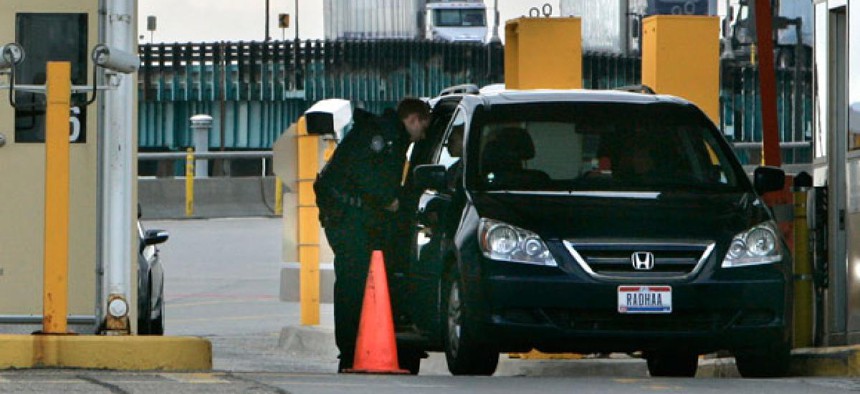
Customs Border Protection officers at the Ambassador Bridge in Detroit, are among those who will likely get furloughed due to the sequester. Carlos Osorio/AP file photo
Furloughs Come to Main Street
Automatic spending cuts will affect federal workers nationwide.
Washington is the capital of the federal workforce, so it’s understandable that furlough fright is strongest here. What will happen to the tide of commuters coursing along K Street or Rock Creek Parkway every morning? But for federal agencies, the sequester is manifest destiny. The U.S. government’s workforce is scattered across the country, and the automatic spending reductions that begin Friday could affect employees all the way to New Mexico, Texas, and Alaska. Any pay cuts will ripple through the broader economy, create yet another drag on growth, and hurt state and local government coffers.
Only 320,000 of roughly 2.1 million federal jobs—15 percent—were located in the greater Washington area as of September 2012, according to the Office of Personnel Management. The other 1.78 million report in large numbers to jobs in California, Florida, New York, North Carolina, Ohio, Pennsylvania, and Texas. These men and women work at military bases, at regional offices for Social Security and the Labor Department, as border-patrol officers, and at national labs.
On average, the typical federal worker is 46 years old and earns $75,000 per year. The law says that workers can be asked to take up to 22 unpaid days off. Between now and the end of the fiscal year on Sept. 30, that would mean a 20 percent pay cut per worker, says Nigel Gault, chief U.S. economist for IHS Global Insight, a macroeconomics forecasting firm. “That is enormous for people,” he says. “They’ll have to cut back.” They’re likeliest to tighten the belt on entertainment, transportation, food, household supplies, and other types of consumer spending.
Just ask 33-year-old Ryan Gibson about the imminent threat. The officer in the Homeland Security Department’s Customs and Border Protection unit is based in Detroit. His wife is a schoolteacher. They’re a middle-class family with two children, ages 8 and 5. In his spare time, he likes to see movies or catch a Tigers game, but he says furloughs will force him to change his spending habits. He doesn’t look forward to the prospect of having to choose be-tween an occasional trip to the movie theater and the fee for his son’s hockey team. “I’m holding out hope that we won’t have to deal with this,” Gibson says in a telephone interview. “The only guidance we’re hearing is that we’re going to have a have a 14-day furlough. It’s frustrating … because we don’t have any answers.”
The sense of uncertainty is bad enough for federal employees across the country, but their job cutbacks could also take a bite out of their local economies. First, reduced spending on consumer goods would lower states’ and municipalities’ income-tax and sales-tax revenues. “I pay Detroit city taxes out of my paycheck,” Gibson says about his hometown, where the unemployment rate was 11.4 percent in December.
Second, sequester cuts would reduce federal spending on contracts and salaries. Roughly 13.3 percent of the local gross domestic product in Alaska, for instance, comes from federal procurement and salaries, according to an analysis by the Pew Center on the States. Other state economies that depend on federal contracts and salaries for a significant share of economic growth include New Mexico (12.8 percent of the state’s GDP), Alabama (8.9 percent), and South Carolina (7.4 percent). Overall, states rely on federal grants for about one-third of their revenue, meaning that even a small falloff can have big reverberations.
“The fact that federal government activity plays a large economic role puts some states in a tough position when they’re trying to plan and budget,” says Anne Stauffer, project director for the Pew Center on the States. If the federal government employs a large percentage of workers in a state, it’s hard to estimate how much the state government will be able to collect from them in taxes. And, of course, states could take an additional hit in cuts to federally funded programs for education, mental health, and child-care assistance.
Worst of all, the threat of these furloughs and their possible effect on local economies arrives just as states are beginning to recover from the recession. While the furloughs won’t cost federal workers their jobs or drag the country back into a recession, sequestration will slow economic growth by as much as 0.6 percent in 2013, according to Macroeconomic Advisers. The furloughs are just one of the ingredients of the across-the-board budget cuts.
The trickiest part of furloughs is that their full impact won’t be known until summer. If they don’t begin until April—a possibility, as agencies are still sorting out what the sequester will mean for them—analysts say monthly economic data should begin to show the fallout in July and Au-gust. “The economic effects of sequestration will not be widespread at first,” says economist Mark Zandi. “But over time, as you move into the summer months, the economy will start moving more slowly.” And the slowdown will be national, mirroring the profile of the cuts, not just centered in Washington.
NEXT STORY: Retirement Resources






